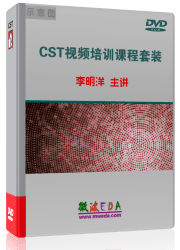HFSS vs. CST
文章來源: 互聯(lián)網(wǎng) 錄入: mweda.com
Experts,
> Are there any benchmarks that compare the performance between
>HFSS and CST available?
>
I'm not aware of any public document that does that. However, I'm
certain many users have made independent evaluation of the two tools for
specific applications of their interest. The evaluation reports are
usually not published in the public domain due to confidentiality and
even legal reasons.
> In going from a frequency domain solver to a time domain solver
>and vise versa what are the trade offs?
>
Let's be specific here and consider CST Microwave Studio as the time
domain solver and Ansoft HFSS as the frequency domain solver. (BTW,
"CST" and "Ansoft" are company names, and "Microwave Studio" (MWS) and
"High Frequency Structure Simulator" (HFSS) are the names of the 3D
electromagnetic field solvers).
MWS solves for transient (time-domain) electric field (E) directly
(natively). That is, it directly solves for electric field in a 3D
space as a function of time. It then indirectly, through Maxwell's
equations, solves for magnetic field (H) as a function of time. Once E
and H are known, many other related parameters (such as current
distribution), can be computed (indirectly). Frequency domain
parameters are indirectly obtained through Fourier transformation.
HFSS solves natively for E field as a function of frequency. H field is
indirectly obtained through Maxwell's equations. Other related
parameters are indirectly computed just like in MWS. Time-domain
parameter are indirectly obtained through inverse Fourier transformation.
The keywords you need to observe from my two paragraphs above are
"direct" and "indirect". Anything computed directly is "potentially"
more accurate than the one computed indirectly. Therefore, transient
parameters computed by MWS are "potentially" more accurate than
transient parameters computed by HFSS. Likewise, frequency-domain
parameters computed by HFSS are "potentially" more accurate than
frequency-domain parameters computed by MWS. You have to meet certain
Fourier transform conditions to obtain accurate results when you change
parameters from one domain to the other. In most cases the conditions
are hard to meet thereby limiting the accuracy.
Any one field component, E or H, can be used for S-parameter
computation. However, the two tools differ slightly in the way they
compute S-parameters. MWS would need to solve the problem as many times
as the number of ports to obtain all S-parameters, while HFSS solves the
problem only once to obtain all the S-parameters. For high port count,
MWS can potentially be much slower than HFSS due to this reason.
For frequency-domain S-parameters to be valid, MWS requires the field at
each port to settle to a particular (specified) level. The smaller the
level the longer the simulation. The field in high Q structures take
extremely long to die off. Such structures may take very long to solve
using MWS transient solver.
MWS uses a time stepping algorithm. That is, it solves for E field one
time step at a time. Once all the time domain E field is computed, the
fields at all frequencies are computed at once. On the other hand, HFSS
solves for E field one frequency at a time. If you need time-domain
results, you will have to solve for many frequencies. It offers at least
two ways of obtaining fast frequency domain results : Fast Sweep and
Interpolating Sweep. They are both "interpolating" schemes hence
introduce their own errors. Generally you cannot really tell which tool
will be faster in producing broadband results of a particular structure.
Neither can you tell which one will be more accurate in that case.
However, for narrowband, you are certainly better off with HFSS.
The other issue is about scaling. Bigger size problem needs longer time
to settle, which leads to longer MWS simulation time even for narrowband
solution. Bigger problems also demand more memory and MWS, being a
Windows software, can't solve problems requiring more than 2GB of
memory. With HFSS, bigger size problems also means huge matrices to
solve, and very long simulation time. In memory terms, HFSS is better as
it can run on UNIX and use up to 8GB of memory (or more).
> Is accuracy of the HFSS and CST at the same level?
>
This is a very important question! When I evaluate a tool I don't only
check whether the tool is accurate, rather I check if it is
*consistently accurate*. I like the tool to be predictable. When I use
the tool to model a number of known structures I expect it to
consistently give accurate results - for all the structures, all the time.
Both MWS and HFSS can be setup to yield accurate results but the effort
needed to achieve that differs considerably between the two tools.
> Is there any type of problem that will not be accurate with one
>or the other?
>
>
Frequency-dependent loss is not handled well by MWS. However, you can do
more kinds of analyses with MWS than HFSS. For example,TDR analysis with
NRZ waveform.
微波EDA (www.tanchuguo.com) 網(wǎng)友回復(fù):
-
網(wǎng)友回復(fù)
全英文,,,,,,,,,,,,,,,,,,,,,,,,,,,,,,太難搞懂 -
網(wǎng)友回復(fù)
-
網(wǎng)友回復(fù)
好,收藏了,謝謝! -
網(wǎng)友回復(fù)
還是略微傾向CST的,但俺還是對CST使用者的水平表示懷疑,N多使用者并不懂收斂分析,得不到正確解(MWS的自適應(yīng)收斂相當(dāng)弱)。這一點上HFSS要好得多,但這一點是“專家”不會顧及的。 -
網(wǎng)友回復(fù)
支持CST呵呵......... -
網(wǎng)友回復(fù)
-
網(wǎng)友回復(fù)
那就來給大家答疑解惑嘛。 -
網(wǎng)友回復(fù)
支持cst!
申明:網(wǎng)友回復(fù)良莠不齊,僅供參考。如需專業(yè)解答,推薦學(xué)習(xí)李明洋老師的CST培訓(xùn)視頻,或咨詢本站專家。
-

CST中文視頻教程,資深專家講解,視頻操作演示,從基礎(chǔ)講起,循序漸進(jìn),并結(jié)合最新工程案例,幫您快速學(xué)習(xí)掌握CST的設(shè)計應(yīng)用...【詳細(xì)介紹】
推薦課程
-
7套中文視頻教程,2本教材,樣樣經(jīng)典
-
國內(nèi)最權(quán)威、經(jīng)典的ADS培訓(xùn)教程套裝
-
最全面的微波射頻仿真設(shè)計培訓(xùn)合集
-
Ansoft Designer 學(xué)習(xí)培訓(xùn)課程套裝
首套Ansoft Designer中文培訓(xùn)教材
-
矢網(wǎng),頻譜儀,信號源...,樣樣精通
-
與業(yè)界連接緊密的課程,學(xué)以致用...
-
Les Besser射頻培訓(xùn)經(jīng)典原版視頻
業(yè)界大牛Les Besser的培訓(xùn)課程...
-
PCB設(shè)計學(xué)習(xí)培訓(xùn)課程套裝
Allegro,PADS,PCB設(shè)計,其實很簡單..
-
Hyperlynx,SIwave,助你解決SI問題
-
現(xiàn)場講授,實時交流,工作學(xué)習(xí)兩不誤


